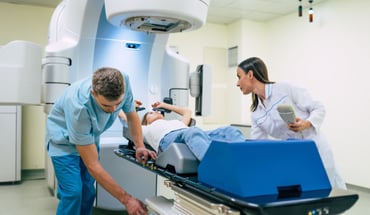
Breast cancer screening is important for early detection when the disease is easier to treat. However, many people are unsure when to schedule a mammogram or why it's so important. Below you'll find information to help you understand the importance of mammograms, alternative screening methods, when to get screened, and what options are available for those who can't afford one. This knowledge can be shared with others to help them make informed decisions about their health.
Why Are Mammograms So Important?
Mammograms are a proven and safe method for detecting breast cancer in its early stages when it’s easiest to treat. A mammogram is an x-ray of the breast that enables the radiologist to observe changes in the breast tissue that you cannot identify during a self-exam or a clinical exam conducted by a health care provider. This detailed image of the breast shows if any abnormal areas in each breast should be reviewed further.
Breast cancer screening mammograms are important for all women, not just those with a family history of breast cancer. According to the National Breast Cancer Foundation, only about 5-10% of breast cancer cases occur in individuals with a family history. In reality, most breast cancers have no specific cause, which means they can affect just about anyone.
The American Cancer Society recommends using both 2D and 3D mammograms for breast cancer screening. It is important to follow your doctor's recommendation on which type to use.
Are There Other Breast Cancer Screening Methods?
According to the American Cancer Society, mammography is the most reliable test to detect breast cancer. Relying solely on a self or clinical exam of the breast is not effective in detecting breast cancer in its earliest stages, as a mammogram is capable of finding it much sooner. However, it is essential for women to be mindful of how their breasts usually look and feel, and report any changes to their doctors immediately if they notice anything unusual.
If you ever notice any changes in your breasts, it’s vital to follow up with your physician to determine if further testing is necessary. If it turns out to be breast cancer, you should consult a breast cancer specialist. The earlier breast cancer is detected and treated, the better the chances of a positive outcome for the patient.
Women with dense breast tissue or those who are considered high-risk may require screening with additional breast cancer detection methods, such as breast ultrasound or breast magnetic resonance imaging (MRI).
- Breast ultrasound is a non-invasive imaging technique that uses sound waves to create images of the inside of the breast.
- Breast MRI uses radio waves and magnets to produce images that a mammogram may not be able to detect.
When to Have Your First Mammogram
Breast cancer screening is guided by your risk level, which can be average or high. To help determine this risk level, the American College of Radiology (ACR) and the Society of Breast Imaging (SBI) recommend all women undergo a risk assessment around the age of 25.
If you are a woman between the ages of 25 and 40 and have not yet discussed your personal risk level for developing breast cancer with your gynecologist or primary care physician, it is important you make that part of your next appointment.
Mammogram Recommendations for Those Considered at Average Risk for Breast Cancer
The American Cancer Society states women considered average risk for developing breast cancer are those who have no personal history of breast cancer, no family history of breast cancer, or no known genetic mutation (BRCA-1 or BRCA-2). For this category, the ACS recommends the following breast cancer screening program:
- Women age 40-44: optional annual mammograms
- Women age 45-54: annual mammograms
- Women 55 and older: if in good health, annual or biennial (every other year) mammograms
Screening should continue as long as a woman is in good health and is expected to live at least ten more years.
Mammogram Recommendation for Those Considered High-risk for Breast Cancer
Women with a higher risk of developing breast cancer only need to meet one of the following criteria:
- Strong family history of breast cancer. If any of your immediate family members (parent, child, or sibling) have had breast cancer, discuss this with your doctor.
- Having dense breast tissue
- Inherited BRCA1 or BRCA2 gene mutations. If you have a family history of breast or ovarian cancer, your doctor may suggest genetic counseling and testing to see if this genetic mutation is present.
- Exposure to chest radiation before age 30
Related reading: Genetic Testing for Breast Cancer
Your doctor may ask you to complete a breast cancer risk questionnaire to determine your lifetime risk. If your lifetime risk is determined to be 20% or greater, you may be advised to follow a high-risk screening process. This may include MRI surveillance and annual mammograms as early as age 25, depending on your risk type.
Based on the risk assessment results and your personal risk factors, your doctor will recommend a breast cancer screening schedule that’s best for you.
What Does a Mammogram Cost?
Most insurance plans cover the cost of screening mammograms. If you do not have insurance, there are low-cost mammogram options available to women in Virginia. The Virginia Department of Health offers the Every Woman's Life program to help uninsured, low-income women gain access to free breast and cervical cancer screening services.
The American Breast Cancer Foundation can also assist with covering the costs of a mammogram if it's not covered by a woman's health insurance. To seek assistance or learn more about ABCF's Breast Cancer Assistance Program, contact the toll-free number, 844-219-2223, to speak with a Program Specialist.
What Should You Do If Your Screening Results Indicate Breast Cancer?
The next step for most patients who have an abnormal area in the breast is to conduct a biopsy. If the biopsy results show cancer is present, you will need to meet with a breast cancer specialist called an oncologist. You will most likely also meet with a breast cancer surgeon. Surgery and treatment options will be prescribed based on your specific case. You will need to talk with your oncologist to determine what’s right for you.
If you are located in Hampton Roads or Northeast North Carolina, our breast cancer doctors are here to provide you with breast cancer resources that may be beneficial to you. This includes information on community resources, support groups, and breast cancer-specific organizations where you can learn more about breast cancer and support options.
Originally posted on 06/2018. Updated on 06/2024.





